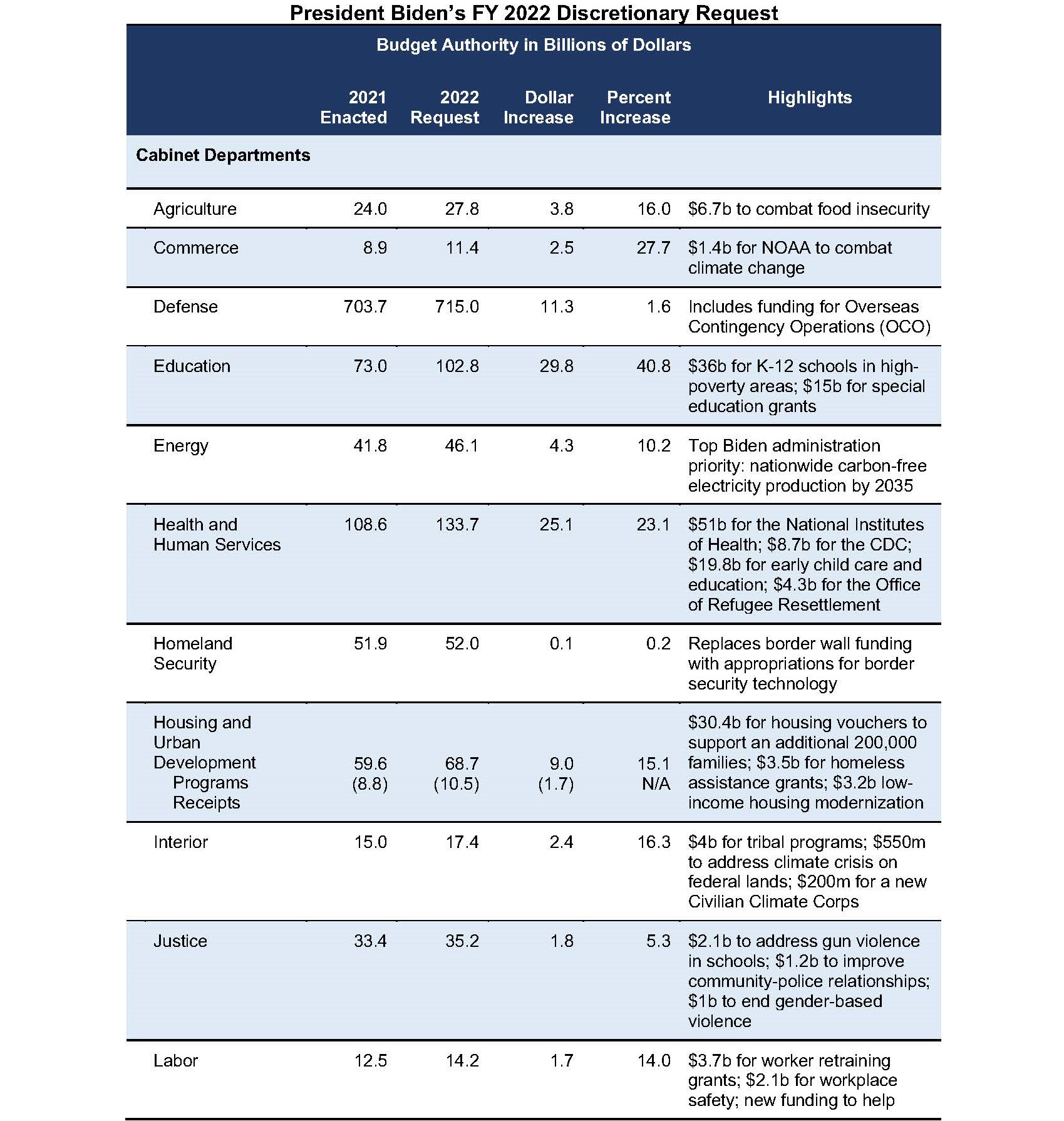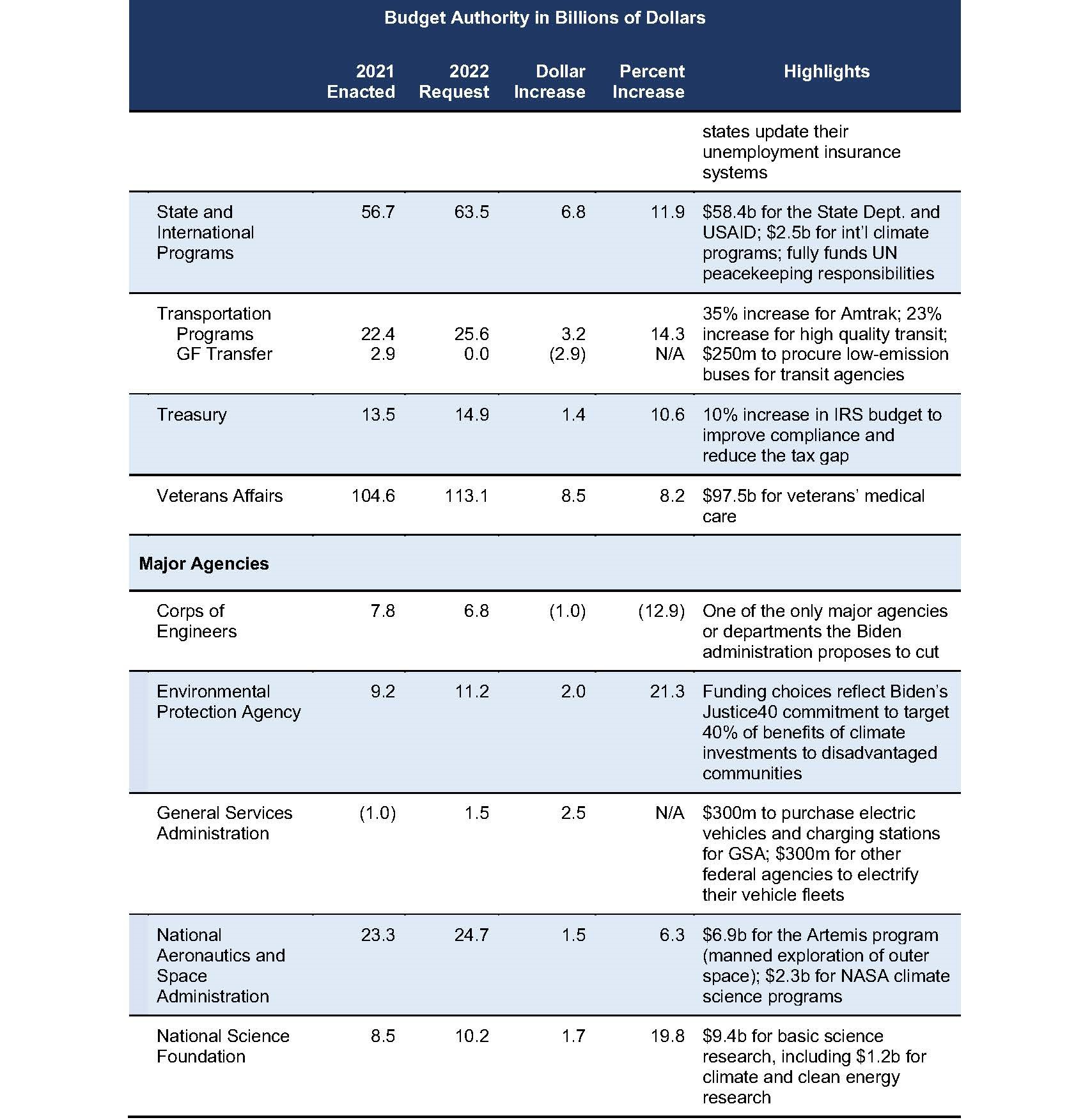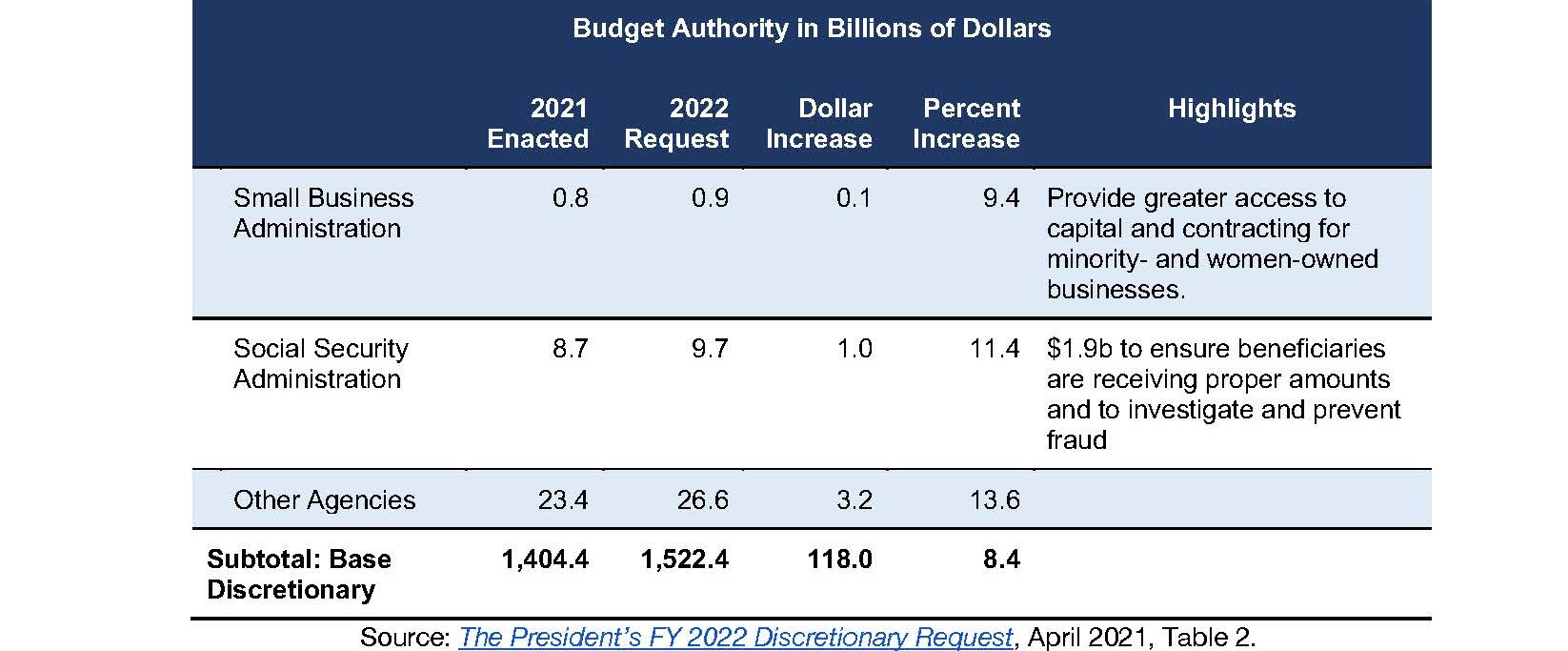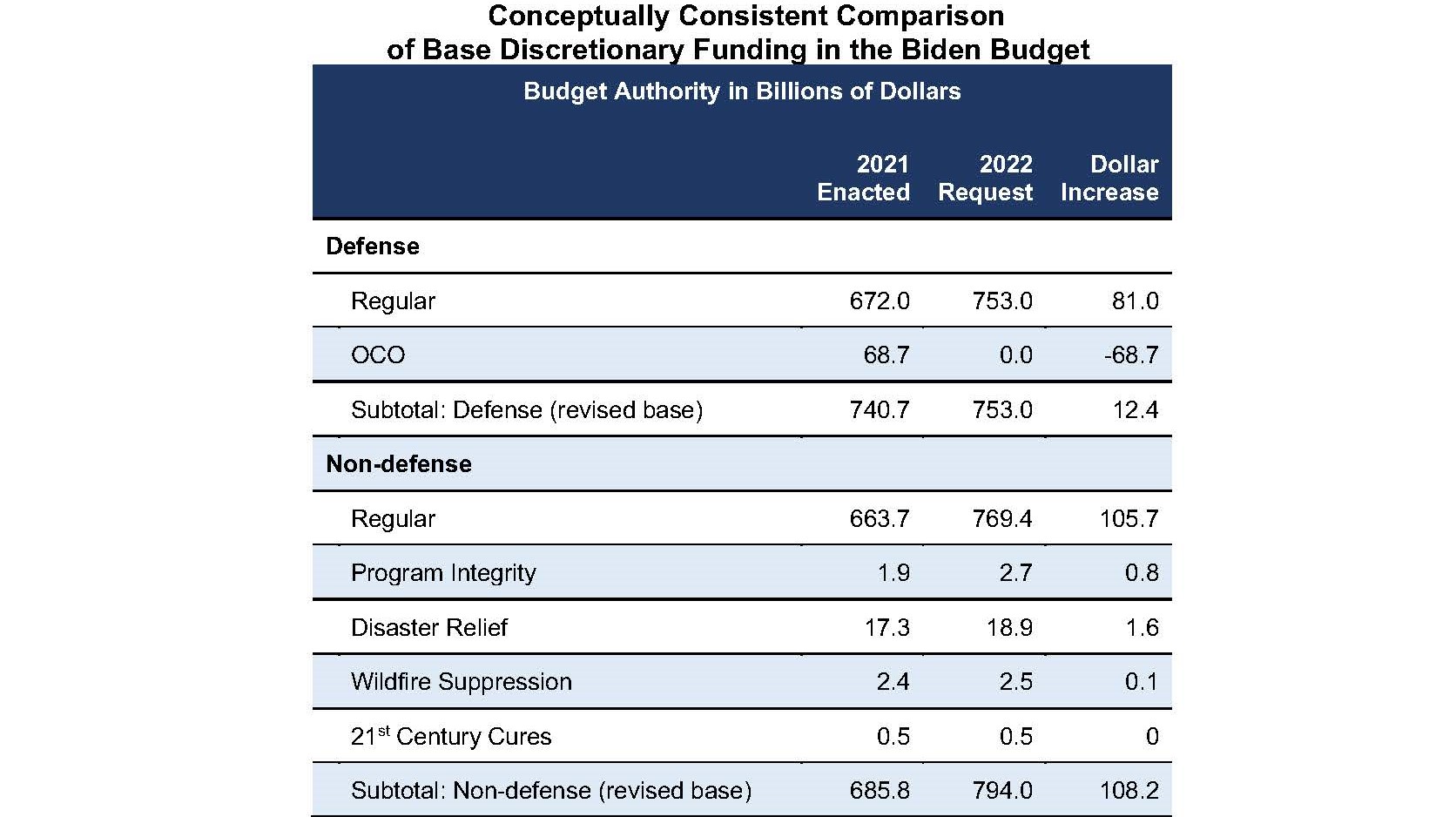After a one-week delay, on April 9th, the Biden administration finally released a peek at their FY 2022 budget. In it, the president proposes to spend $1.5 trillion on base (regular) discretionary programs next fiscal year, an increase of $118 billion, or 8.4 percent, over FY 2021 enacted levels. Spending on regular non-defense discretionary programs would receive the bulk of the increase, benefitting from nearly $106 billion more in base funding over the prior year, an increase of 15.9 percent. Regular defense spending would barely keep pace with inflation, rising $12.3 billion, or 1.7 percent.
An Ultra-Skinny Budget
By law, a president’s complete budget is due to Congress by the first Monday in February. But in recent years, new presidents (beginning with Bill Clinton), have delayed their inaugural blueprints, choosing instead to submit a preliminary “skinny” budget composed of a few key tables, followed weeks later by the regular, detailed, multi-volume tome.
President Biden stretched the boundaries of this tradition, however, and submitted an ultra-skinny budget containing just his discretionary proposal for the upcoming fiscal year. Missing are any outyear projections beyond 2022 or any details on the president’s mandatory spending and revenue proposals.
Context Matters
Discretionary spending is only one-third of the annual budget, though, and it is hard to put the president’s discretionary proposal into context without knowing the other two-thirds of the budget. For example, will President Biden propose to extend some, all, or none of the 2021 Rescue Act anti-child poverty tax credits that expire at the end of this year? Does his budget make accommodations for the 2017 individual tax cuts that will expire in 2025? Does he intend to preserve Medicare Part A beyond 2026 when its trust fund is exhausted, and if so, how?
Moreover, the president’s $1.5 trillion discretionary budget arrives on the heels of a $1.9 trillion COVID relief bill, a $2.3 trillion infrastructure proposal, and an anticipated $1 trillion social spending package. Debt held by the public is expected to top 102 percent of GDP in FY 2021 and accelerate afterwards. Will the president propose equally large revenue increases or mandatory spending cuts in his full budget to be released later this spring? Or will the discretionary proposals for FY 2022 merely add incrementally to an already bleak outlook for federal deficits and debt?
FY 2022 Discretionary Proposals Reflect Biden Priorities
A presidential budget rarely survives Congressional scrutiny intact, but it does set the tone for negotiations by communicating an administration’s core values and policy priorities. In the Biden budget, programs that address climate change receive big funding boosts, as well as social safety net programs that benefit low-income households in underserved communities (education, healthcare, housing, small business lending, etc.).
The President’s FY 2022 Discretionary Request



-
No real apples-to-apples comparison. The Biden budget changes the definition of base (regular) defense spending to include amounts that in prior years were designated for “Overseas Contingency Operations” and were exempt from the discretionary spending caps (per the Budget Control Act). This is an appropriate and welcome change as the designation was often misused and OCO spending lacked transparency.
The non-defense side of the ledger, however, has had its own BCA cap workarounds for which the Biden budget has requested appropriations in FY 2022. Examples include funding for program integrity initiatives (fraud prevention), disaster relief, wildfire suppression, and CARES Act/opioid addiction assistance funding. If OCO is going to be included in the regular (base) discretionary spending of the Biden budget, then conceptual consistency demands that funding for these non-defense add-ons also be included in non-defense regular (base) appropriations.
The result is a non-defense base amount of $794 billion (not $769 billion as reported in the Biden budget) and an increase in FY 2022 non-defense base discretionary spending that is actually $2.5 billion higher than the Biden administration stipulates in its budget documents ($108.2 billion increase over 2021 compared to Biden’s $105.7 billion increase). For a $1.5 trillion budget, this amount is relatively small, but $2.5 billion per year (plus inflation) over 10 years adds up.

-
Counter to historical norms, regular (base) non-defense spending would exceed defense spending. The proposed spending increase on climate-related programs and aid to low-income and underserved households is so significant that for the first time in modern history, funding for regular (base) non-defense programs would eclipse the defense budget – even with OCO shifted into the base defense budget.
-
Just say “no” to CHIMPs. During the BCA era, appropriators relied on budget gimmicks called CHIMPS to create an illusion of budgetary savings in certain mandatory programs that could then be redirected to discretionary programs without violating the spending caps. But now that the cap era is ending, there is no rational use for CHIMPS other than to obscure from taxpayers the total amount spent. The Biden budget assumes $26 billion in CHIMPS, but Congressional appropriators should just say no.
-
It’s unclear whether the ultra-skinny budget reflects the Biden infrastructure proposal. Another disappointment of a lack of a complete budget: it is difficult to discern whether or not the ultra-skinny discretionary proposal reflects the budgetary contours of the president’s $2 trillion infrastructure proposal. Without all the normal accoutrements of a normal budget (mandatory, discretionary, AND revenue projections by program for the upcoming fiscal year and the ensuing 9 fiscal years), it’s simply hard to know if there is consistency in this proposal.
-
Did Biden consider the “parity principle” when proposing the large increase in non-defense discretionary spending? The “parity principle” refers to the equality between increases in regular (base) defense and nondefense spending that were commonplace under the Budget Control Act. The Biden budget proposes $753 billion for defense programs in the upcoming fiscal year, an increase of $12.7 billion, or 1.7 percent– significantly below the 3% to 5% bump advocated by GOP leaders and much lower than the nearly $105 billion increase in non-defense spending. Although the BCA caps disappear in FY 2022, Republicans may still demand equal dollar-for-dollar increases in defense and nondefense spending as their price for avoiding a filibuster. Biden risks losing votes from the progressive left if he negotiates the defense level higher or the non-defense budget lower to meet possible Republican demands for parity.
-
The Biden discretionary budget was made possible by expiration of the Budget Control Act. For the last decade, discretionary appropriations have been constrained by statutory caps enacted as part of the Budget Control Act of 2011. Those caps were enforced by sequester, making it nearly impossible to significantly increase discretionary spending in any year, at least not without bipartisan compromise. The BCA caps expire at the end of the current fiscal year, providing the Biden administration with the statutory freedom to propose his large and one-sided increase in FY 2022 discretionary appropriations.




